COM Express Ultra module debuts
Mar 9, 2009 — by LinuxDevices Staff — from the LinuxDevices Archive — 22 views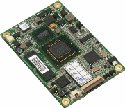 Aaeon announced a COM (computer on module) exploiting the newly proposed “COM Express Ultra” standard. The 84 x 55mm NanoCOM-U15 includes an SDVO (serial digital video out) connector, an Atom Z5xx-series CPU, and up to 4GB of SSD (solid state disk) storage, the company says.
Aaeon announced a COM (computer on module) exploiting the newly proposed “COM Express Ultra” standard. The 84 x 55mm NanoCOM-U15 includes an SDVO (serial digital video out) connector, an Atom Z5xx-series CPU, and up to 4GB of SSD (solid state disk) storage, the company says.
(Click here for a slightly larger image of Aaeon's NanoCOM-U15)
The NanoCOM-U15 appears to be among the first COMs to take full advantage of the newly proposed COM Express Ultra standard, recently submitted to the PICMG (PCI Industrial Computer Manufacturers Group) by Aaeon, along with Adlink, Advantech, and Kontron. COM Express Ultra is based on the 84 x 55mm nanoETXexpress form factor, with a single 220-pin COM Express connector. The spec also defines an optional connector for SDVO, a proprietary Intel display interface (more about COM Express Ultra below).
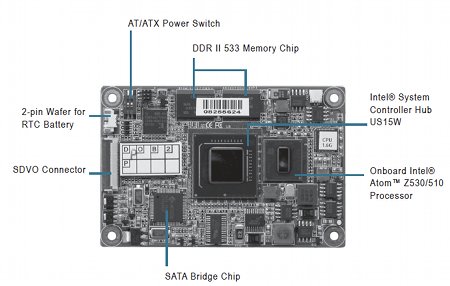
Aaeon's NanoCOM-U15 has an SDVO connector (left)
(Click to enlarge)
As the above picture of the NanoCOM-U15 shows, Aaeon has taken the opportunity to add SDVO to its new COM. According to the company, this lets the small device support dual independent displays, since LVDS output is relayed over the Type I COM Express connector.
The NanoCOM-U15 uses Intel's 1.1GHz Atom Z510 or 1.6GHz Z530 CPU, paired, naturally, with the chipmaker's comparatively large SCH US15W companion chip. The 1.1GHz version has a 400MHz frontside bus, while the 1.6GHz steps up to a 533MHz frontside bus, according to Aaeon.
Like Toradex's recent, identically-sized Robin module, the NanoCOM-U15 doesn't have room for an SODIMM slot. Therefore, it's provided with either 512MB or 1GB of soldered-on DDR2 RAM. This may optionally be supplemented by up to 4GB of PATA-interfaced SSD storage, according to Aaeon.
Interfaces provided by the NanoCOM-U15's COM Express Type I connector include PCIe x1, gigabit Ethernet, an SATA II port, SDIO, LPC, SMbus, and eight USB 2.0 ports. Also included are high-definition audio and up to eight GPIOs, the company says.
Features and specifications listed by Aaeon for the NanoCOM-U15 include:
- Processor — Intel Atom Z510 (1.1GHz) or Z530 (1.6GHz)
- Memory — 512MB or 1GB of soldered-on DDR2 RAM, and up to 4GB of flash storage
- Display — Supports LVDS and SDVO displays, with resolutions up to 1366 x 768 for LVDS and 1280 x 1024 for SDVO
- Networking — Gigabit Ethernet
- Other I/O:
- 8 x USB 2.0
- 1 x SATA
- HD audio
- 8 x GPIO
- 8 x USB 2.0
- Expansion:
- LPC
- SMB
- 1 x PCI Express x1
- 1 x SDIO
- LPC
- Power consumption — n/s
- Power supply — 4.75VDC to 14.7VDC input range
- Dimensions — 3.3 x 2.15 inches (84 x 55mm)
- Operating temperature — 0 to 60 deg. C (32 to 140 deg. F)
Now re-named COM Express Ultra, the nanoETXexpress design derives from 2003's ETXexpress, created by Kontron and later adopted as the PICMG COM Express standard. In 2006, Kontron introduced the cut-down version of COM Express known as microETXexpress, and nanoETXexpress followed in July 2007.
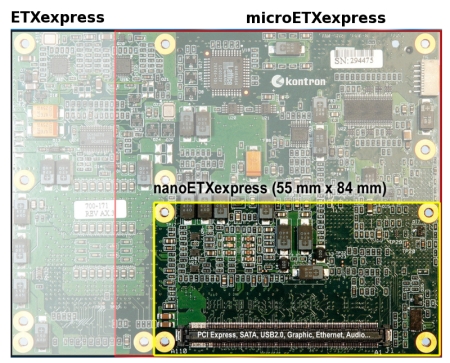
Comparison of COM form-factors
(Click to enlarge)
All three COMs share the same baseboard interface connector design and pinout, and have overlapping mechanical assemblies, as illustrated above. Footprints vary, as follows:
- COM Express (formerly ETXexpress):
- basic form-factor — 125 x 95mm (4.9 x 3.7 inches)
- extended form-factor — 155 x 110mm (6.1 x 4.33 inches)
- microETXexpress (now proposed as COM Express Compact) — 95 x 95mm (3.7 x 3.7 inches)
- nanoETXexpress (now proposed as COM Express Ultra) — 84 x 55mm (3.3 x 2.16 inches)
 Kontron's nanoETXexpress-SP (Click image for further information) |
According to the newly published revision 1.0, the nanoETXexpress specification uses a Type I COM Express pinout, sending almost all its signals over a single 220-pin connector (below left). Optionally, a 30-pin Hirose FH12-compatible connector can be located on the side of a module (below right), providing access to SDVO signals.
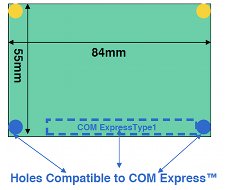
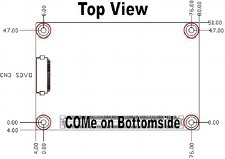
COM Express Ultra (left), aka nanoETXexpress, allows for an add-on SDVO connector (right)
(Click either to enlarge)
Peter Yang, a product manager responsible for COMs at Aaeon, said, “We support the Ultra form factor because it fits perfectly into our product portfolio. We had already implemented the Atom processor on our COM-U15 module, so the step to implementing the nanoCOM-U15 was therefore easy.”
Availability
Aaeon did not provide pricing or availability information for the nano-COM-U15. Details of operating system support have not been released, either, but most modules using the Intel chipset concerned are compatible with Linux, Windows XP Embedded, Windows XP, Windows Vista, Windows CE 6.0, VxWorks, and other standard x86 RTOSes.
This article was originally published on LinuxDevices.com and has been donated to the open source community by QuinStreet Inc. Please visit LinuxToday.com for up-to-date news and articles about Linux and open source.